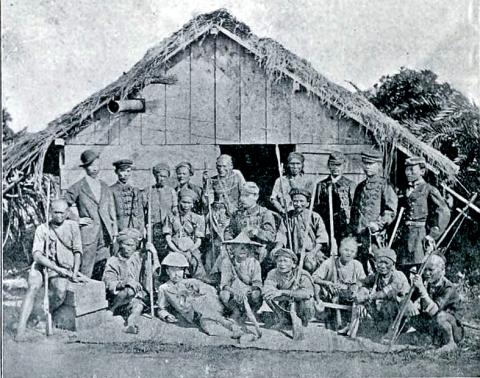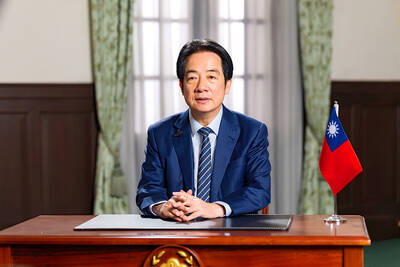In early May 1874, just 20 years after US Commodore Matthew Perry forcefully opened up the isolationist empire to the rest of the world, Japanese troops headed outside of Japan’s borders for the first time in more than 200 years. Their destination: Taiwan.
With them was Edward Howard House, a Bostonian musical prodigy who moved to New York and became a drama critic. During the American Civil War, House served as correspondent for the New York Tribune, almost getting shot in the process.
He traveled to Japan in 1870 when the country was still in political strife as a stringer for the Tribune and later for the New York Times. He also worked as an English professor and founded the English-language Tokio Times.

Photo: Han Cheung, Taipei Times
House accompanied the Japanese troops to Taiwan as a correspondent for the New York Herald, and a year later published The Japanese Expedition to Formosa, a first-person account of what would later be known locally as the Mudan Incident (牡丹社事件).
THE MUDAN INCIDENT
The story originates in late 1871, when two ships from the Kingdom of Ryukyu were blown off course during a storm and were shipwrecked in Taiwan, which was then controlled by a Qing Dynasty with little desire to develop it. One ship landed in the prefectural capital of Tainan without much incident, but the other ended up further south, near today’s Manjhou Township (滿州) in Pingtung.

Courtesy of Wikimedia Commons
Sixty-six passengers made it to land, where they met two Han Chinese who seized their possessions but warned them not to head west where they would meet the headhunting “big ear ghosts.” Distrusting of the men, the castaways headed west anyways — and indeed encountered the “ghosts,” which were Paiwan Aborigines with stretched earlobes.
The Aborigines gave them food and shelter, but forbade them from leaving the village until they came back from a hunting trip. When the sailors escaped, the Aborigines followed and killed 54 of them, the rest being rescued by Han Chinese settlers and taken to safety to Tainan.
The Qing Dynasty, who had no control over the southern (or eastern) Aborigines, refused, or was simply unable, to help, and the event became an excuse for the fledgling Meiji government to attempt a take over of the non-Qing controlled areas of Taiwan and also assert its authority over Ryukyu, which paid tribute to China.
The Japanese government hesitated after opposition by the UK and the US — but on April 27, 1872, expedition commander Saigo Judo refused to wait anymore, defying orders and setting sail on the Yuko Maru. House was on this ship.
LIFE IN HENGCHUN
House’s account was more than just a war journal, as there was not a whole lot of action outside of minor skirmishes and guerrilla attacks except for a three-pronged assault on the Paiwan settlement of Mudan, whose villagers were not responsible for killing the sailors but refused to participate in negotiations.
Of course, there are the supremacist comments, for example this passage describing a Han Chinese settler: “[He] was singularly gifted with good looks, for one of his race.” In fact, he comments on the good looking-ness of practically every person he writes about.
But there are also thoughtful observations: “[The settlers] have a sort of openness and independence of bearing that would not be found in a crowded Chinese city, which is doubtless attributable to their freedom from oppressive authority and self-reliant ways of life.”
Much of the time was spent making military preparations and negotiating in Han Chinese settlements. House notices the prevalence of weapons here — guns, scabbards, bows with iron arrows, spears and lances, all “displayed conspicuously” — a testament to the lawlessness of the area.
There are culture clashes, such as when the Japanese soldiers stripped and started bathing in water tubs in plain sight in the village, which caused a stir. Locals relentlessly pestered the troops to let them try the Gatling guns — even coming up with various schemes — to no avail.
Also interesting was that when the Japanese hired 400 locals to help them build the camp, many who showed up were women with children still strapped to their backs and elderly — and there was even a blind man. House describes them as unruly and inefficient, even taking up their guns and going on strike for higher wages at one point.
The book goes on and follows the military operations, negotiations with Aborigines and later-arriving Chinese officials and tropical epidemics among Japanese troops — but it is the descriptions of everyday life in a wild and lawless Taiwan that sets it apart from other books on the incident.
By the end of the incident, Japan had mobilized more than 6,000 people and spent far more than the reparations it received from the Qing. While the expedition paved the way to the empire’s eventual annexation of Ryukyu, all the troops retreated with no territorial gains in Taiwan.
It did not matter anyway, as just 20 years later, Japan got more than the Aborigine areas — it swallowed Taiwan entirely.
Taiwan in Time, a column about Taiwan’s history that is published every Sunday, spotlights important or interesting events around the nation that have anniversaries this week.

This month the government ordered a one-year block of Xiaohongshu (小紅書) or Rednote, a Chinese social media platform with more than 3 million users in Taiwan. The government pointed to widespread fraud activity on the platform, along with cybersecurity failures. Officials said that they had reached out to the company and asked it to change. However, they received no response. The pro-China parties, the Chinese Nationalist Party (KMT) and Taiwan People’s Party (TPP), immediately swung into action, denouncing the ban as an attack on free speech. This “free speech” claim was then echoed by the People’s Republic of China (PRC),

Most heroes are remembered for the battles they fought. Taiwan’s Black Bat Squadron is remembered for flying into Chinese airspace 838 times between 1953 and 1967, and for the 148 men whose sacrifice bought the intelligence that kept Taiwan secure. Two-thirds of the squadron died carrying out missions most people wouldn’t learn about for another 40 years. The squadron lost 15 aircraft and 148 crew members over those 14 years, making it the deadliest unit in Taiwan’s military history by casualty rate. They flew at night, often at low altitudes, straight into some of the most heavily defended airspace in Asia.

Many people in Taiwan first learned about universal basic income (UBI) — the idea that the government should provide regular, no-strings-attached payments to each citizen — in 2019. While seeking the Democratic nomination for the 2020 US presidential election, Andrew Yang, a politician of Taiwanese descent, said that, if elected, he’d institute a UBI of US$1,000 per month to “get the economic boot off of people’s throats, allowing them to lift their heads up, breathe, and get excited for the future.” His campaign petered out, but the concept of UBI hasn’t gone away. Throughout the industrialized world, there are fears that

The Democratic Progressive Party (DPP) controlled Executive Yuan (often called the Cabinet) finally fired back at the opposition-controlled Legislative Yuan in their ongoing struggle for control. The opposition Chinese Nationalist Party (KMT) and Taiwan People’s Party (TPP) acted surprised and outraged, but they should have seen it coming. Taiwan is now in a full-blown constitutional crisis. There are still peaceful ways out of this conflict, but with the KMT and TPP leadership in the hands of hardliners and the DPP having lost all patience, there is an alarming chance things could spiral out of control, threatening Taiwan’s democracy. This is no